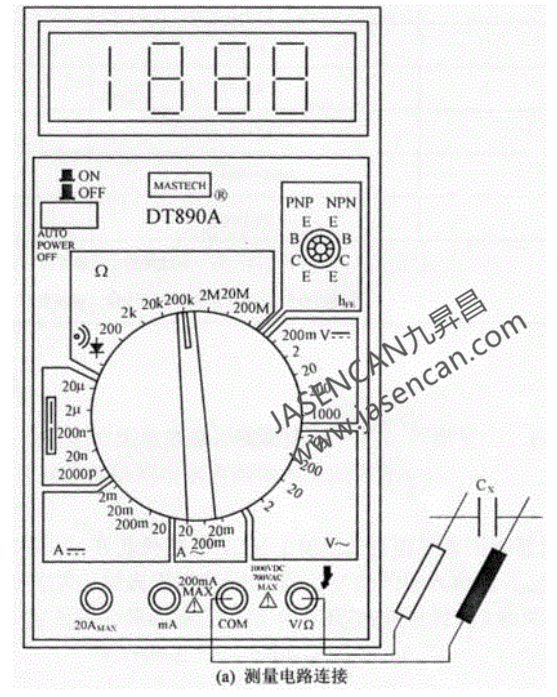Multimeter measuring capacitance method
Time:2021.11.19
View:

Capacitors are one of the most frequently used electronic components in electronics, but many people do not know how to detect capacitance. Below we introduce several methods for testing capacitance with a multimeter. Capacitors are one of the most commonly used electronic components. The general letter symbol for capacitors is "C". Capacitors are mainly composed of metal electrodes, dielectric layers and electrode leads. The two electrodes are insulated from each other. Therefore, it has the basic performance of "blocking DC and communicating with AC".
Use a digital multimeter to detect capacitors, you can do as follows:

1. Direct detection with capacitance file
Some digital multimeters have the function of measuring capacitance, and their ranges are divided into five ranges: 2000p, 20n, 200n, 2μ and 20μ. During measurement, the two pins of the discharged capacitor can be directly inserted into the Cx jack on the meter board, and the display data can be read after selecting the appropriate range.
000p range, suitable for measuring capacitances less than 2000pF; 20n range, suitable for measuring capacitances between 2000pF and 20nF; 200n range, suitable for measuring capacitances between 20nF and 200nF; 2μ range, suitable for measuring capacitances between 200nF and 2μF The capacitance; 20μ gear, suitable for measuring the capacitance between 2μF and 20μF.
Experience has proved that some models of digital multimeters (such as DT890B+) have large errors when measuring small-capacity capacitors below 50pF, and there is almost no reference value for measuring capacitors below 20pF. At this time, the series method can be used to measure small-value capacitors. The method is: first find a capacitor of about 220pF, measure its actual capacity C1 with a digital multimeter, and then connect the small capacitor to be tested in parallel to measure its total capacity C2, then the difference between the two (C1-C2) is The capacity of the small capacitor to be tested. It is very accurate to use this method to measure small capacitance of 1-20pF.
2. Detect with resistance file
Practice has proved that the charging process of the capacitor can also be observed with a digital multimeter, which is actually a discrete digital quantity that reflects the change of the charging voltage. Assuming that the measurement rate of the digital multimeter is n times/second, in the process of observing the charging of the capacitor, n independent and successively increasing readings can be seen every second. According to this display feature of the digital multimeter, the quality of the capacitor can be detected and the size of the capacitance can be estimated. The following describes the method of using the resistance file of a digital multimeter to detect capacitors, which is of practical value for meters without a capacitance file. This method is suitable for measuring large-capacity capacitors from 0.1μF to several thousand microfarads.
1. Measurement operation method
As shown in the figure, set the digital multimeter to the appropriate resistance range, and the red and black test leads respectively touch the two poles of the capacitor Cx under test. At this time, the displayed value will gradually increase from "000" until the overflow symbol "1" is displayed. If “000” is always displayed, it means that the capacitor is short-circuited; if the overflow is always displayed, there may be an open circuit between the capacitors, or the selected resistance file may not be appropriate. When checking the electrolytic capacitor, pay attention to that the red test lead (with positive charge) is connected to the positive electrode of the capacitor, and the black test lead is connected to the negative electrode of the capacitor.
2. Measuring principle
The measuring principle of measuring capacitor with resistance profile is shown in Figure 5-11(b). During the measurement, the positive power supply charges the capacitor Cx under test through the standard resistance R0. At the moment when the charging starts, because Vc=0, it displays "000". As Vc gradually increases, the displayed value increases. When Vc=2VR, the meter starts to display the overflow symbol "1". The charging time t is the time required for the display value to change from "000" to overflow, and this time interval can be measured with a quartz watch.

3. Use DT830 digital multimeter to estimate the measured data of electric capacity
When using the DT830 digital multimeter to estimate the capacitance of a capacitor from 0.1μF to several thousand microfarads, you can select the resistance file according to Table 5-1. The range of the measurable capacitance and the corresponding charging time are given in the table. The data listed in the table also has reference value for other types of digital multimeters.
The principle of selecting the resistance range is: when the capacitance is small, the high resistance range should be used, and when the capacitance is large, the low resistance range should be selected. If the high-resistance mode is used to estimate large-capacity capacitors, since the charging process is very slow, the measurement time will last a long time; if the low-resistance mode is used to check small-capacity capacitors, because the charging time is extremely short, the meter will always display overflow and no change process can be seen .
4. Detect with voltage file
Using a digital multimeter to detect capacitors with DC voltage is actually an indirect measurement method. This method can measure small-capacity capacitors from 220pF to 1μF, and can accurately measure the size of the capacitor's leakage current.

1. Measurement method and principle
The measurement circuit is shown in the figure, and E is an external 1.5V dry battery. Set the digital multimeter to DC 2V, connect the red test lead to one electrode of the capacitor Cx under test, and connect the black test lead to the negative electrode of the battery. The input resistance of the 2V file is RIN=10MΩ. After the power is turned on, the battery E is charged to Cx through RIN, and the relationship between the voltage Vc.Vc and the charging time t is established as

Here, since the voltage across RIN is the instrument input voltage VIN, RIN actually also functions as a sampling resistor. Obviously, VIN(t)=E-Vc(t)=Eexp(-t/RINCx)(5-2)
The graph input voltage VIN (t) and the charging voltage Vc (t) on the measured capacitance curve. It can be seen from the figure that the change process of VIN(t) and Vc(t) is exactly the opposite. The change curve of VIN(t) decreases with the increase of time, while Vc(t) increases with the increase of time. Although what the meter shows is the change process of VIN-(t), it indirectly reflects the charging process of the capacitor Cx under test. During the test, if Cx is open (no capacity), the displayed value is always "000". If Cx is internally short-circuited, the displayed value is always battery voltage E, which will not change with time.

It shows that when the circuit is just turned on, t=0, VIN=E, the initial display value of the digital multimeter is the battery voltage, and then as Vc(t) increases, VIN(t) gradually decreases until VIN=0V, Cx The charging process is over, at this time:

Using a digital multimeter to detect capacitors at the voltage level can not only check small-capacity capacitors of 220pF~1μF, but also measure the leakage current of the capacitor at the same time. Suppose the leakage current of the measured capacitor is ID, and the last stable value displayed by the meter is VD (the unit is V), then

2. Examples Example 1: The measured capacitance is a 1μF/160V fixed capacitor, using the 2VDC file (RIN=10MΩ) of the DT830 digital multimeter. Connect the circuit according to Figure 5-12. Initially, the meter displayed 1.543V, and then the displayed value slowly decreased. After about 2min, the displayed value stabilized at 0.003V. Based on this, the leakage current of the tested capacitor was calculated to be only 0.3nA, indicating the quality good.

Example 2: The capacitor under test is a 0.022μF/63V polyester capacitor, and the measurement method is the same as Example 1. Due to the small capacity of this capacitor, VIN(t) drops quickly during measurement. After about 3 seconds, the displayed value drops to 0.002V. Substitute this value into equation (5-3), and calculate the leakage current to be 0.2nA.
3. Matters needing attention
(1) Before the measurement, the two pins of the capacitor should be short-circuited and discharged, otherwise the change process of the reading may not be observed.
(2) Do not touch the capacitor electrode with both hands during the measurement process, so as to prevent the meter from jumping.
(3) During the measurement process, the value of VIN(t) changes exponentially. At the beginning, it drops quickly, and as time goes by, the speed of decline will become slower and slower. When the capacity of the capacitor Cx under test is less than several thousand picofarads, because VIN(t) initially drops too fast, and the measurement rate of the meter is low, it is too late to reflect the initial voltage value, so the initial display value of the meter is lower than the battery Voltage E. (4) When the measured capacitor Cx is greater than 1μF, in order to shorten the measurement time, the resistance profile can be used for measurement. But when the capacity of the capacitor under test is less than 200pF, it is difficult to observe the charging process because the change in readings is very short.

4. Use the buzzer file to detect
Using the buzzer file of the digital multimeter, you can quickly check the quality of the electrolytic capacitor. The measurement method is shown in Figure 5-14. Set the digital multimeter to the buzzer position, and use two test leads to contact the two pins of the capacitor Cx to be tested. A short buzzer should be heard, then the sound stops, and the overflow symbol "1" is displayed at the same time. Then, swap the two test leads for another measurement. The buzzer should sound again, and finally the overflow symbol "1" is displayed. This situation indicates that the measured electrolytic capacitor is basically normal. At this point, you can dial to 20MΩ or 200MΩ to measure the leakage resistance of the capacitor to judge whether it is good or bad.





